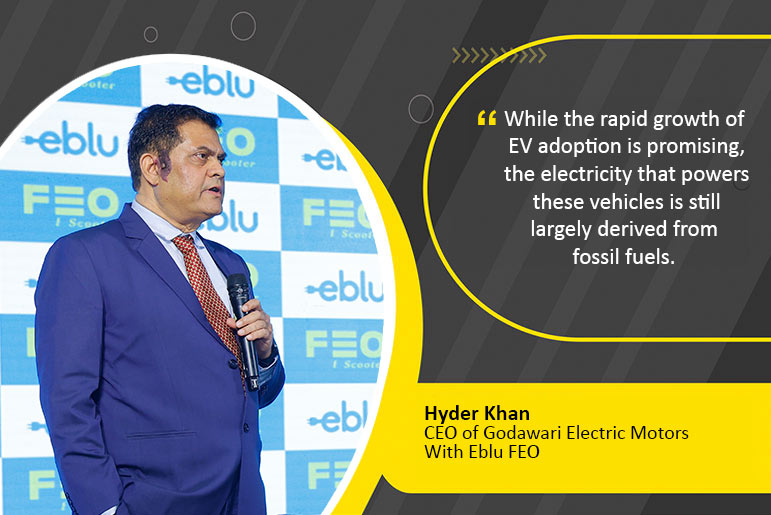The evolution of transportation has reached a pivotal crossroads, where the need for sustainability intersects with technological advancement. Electric mobility (e-mobility), powered by renewable energy, is emerging as a transformative force in addressing the dual challenges of environmental degradation and fossil fuel dependence. For India, a country grappling with escalating air pollution and a burgeoning energy demand, the integration of renewable energy into the electric vehicle (EV) ecosystem offers a unique opportunity to redefine its energy and transportation paradigms.
The Expanding Footprint of Electric Vehicles in India
India’s push towards electric mobility has gained significant momentum in recent years. The central government’s Faster Adoption and Manufacturing of Hybrid and Electric Vehicles (FAME) initiative, now in its second phase, has catalyzed EV adoption by offering financial incentives, bolstering local manufacturing, and fostering a supportive policy environment. NITI Aayog estimates that by 2030, EVs will account for a substantial share of India’s vehicle market, with ambitious targets set for both private and commercial vehicles.
While the rapid growth of EV adoption is promising, the electricity that powers these vehicles is still largely derived from fossil fuels. This reliance diminishes the environmental benefits of EVs. Hence, the integration of renewable energy into EV charging and production processes is crucial for realizing the full potential of green mobility.
Renewable Energy: The Backbone of Green Mobility
India’s renewable energy sector has witnessed exponential growth over the last decade. The country has achieved a renewable energy capacity of nearly 191 GW as of March 2024, with solar and wind energy accounting for the lion’s share. India’s geographical diversity allows for extensive harnessing of renewables, with a solar potential exceeding 750 GW and a wind potential of 900 GW.
The convergence of renewable energy and e-mobility holds immense promise. By powering EVs with clean energy, India can significantly reduce its carbon emissions. The Ministry of Power’s directive that all public EV charging stations must integrate renewable energy sources by 2030 exemplifies this commitment. Furthermore, the National Solar Mission, which aimed to deploy 20 GW of solar power by 2022, surpassed its target in 2018, four years ahead of the deadline. Such initiatives serve as a foundational pillar for creating a sustainable energy ecosystem for EVs.
The Environmental and Economic Impact
Integrating renewable energy into electric mobility offers profound environmental benefits. Road transport is one of the largest contributors to greenhouse gas emissions in India, accounting for 12% of the total. Electrifying vehicles and powering them with renewable energy can drastically lower emissions, contributing to India’s commitment under the Paris Agreement to reduce its carbon intensity by 45% by 2030.
On the economic front, reducing dependence on imported fossil fuels can save billions annually. India, one of the largest importers of crude oil, saw a 12% rise in its oil imports expenditure in the first half of FY25, reaching a whopping $71.3 billion. By transitioning to renewable energy for e-mobility, India can enhance its energy security, lower trade deficits, and redirect funds towards infrastructure development and innovation.
The Development of Green Charging Infrastructure
One of the most critical aspects of integrating renewable energy into electric mobility is the development of green charging infrastructure. Solar-powered EV charging stations are gaining traction in urban and semi-urban areas. These stations not only mitigate grid dependency but also ensure that EVs are charged with clean energy. Start-ups and established players alike are spearheading this innovation.
For instance, initiatives in states like Rajasthan and Gujarat are exploring the potential of solar rooftops for EV charging stations. Companies are also investing in hybrid systems that combine solar and wind energy with battery storage to ensure consistent energy availability. Such systems are especially beneficial in regions where renewable energy generation is seasonal or intermittent.
Grid-integrated EV charging stations are another innovation gaining ground. These systems prioritize the use of renewable energy whenever available, dynamically adjusting to grid conditions. Such advancements not only promote renewable integration but also enhance the overall stability of the power grid.
More importantly, the integration of renewable energy into e-mobility extends beyond the charging phase to the entire EV supply chain. The production of EV batteries, a critical component of electric vehicles, is often energy-intensive and environmentally taxing. By utilizing renewable energy in manufacturing facilities, companies can significantly reduce the carbon footprint of EVs.
Challenges in the Transition
Despite its promise, the integration of renewable energy into electric mobility faces significant challenges. The lack of widespread charging infrastructure remains a bottleneck. While India has made progress, with more than 12,000 public charging stations installed as of February 2024, this number is insufficient for the growing EV population. Furthermore, only a small fraction of these stations are powered by renewables.
Another challenge lies in the variability of renewable energy generation. Solar and wind energy, while abundant, are intermittent by nature. Developing robust energy storage solutions and smart grid systems is essential to ensure a reliable supply for EVs.
Policy coherence is another area of concern. While national policies like FAME II and state-specific EV policies provide a roadmap, discrepancies in implementation and regulation can slow progress. Aligning these policies with renewable energy goals is crucial for a seamless transition.
The Path Ahead
India’s journey towards integrating renewable energy into electric mobility is both ambitious and imperative. Collaborative efforts from the government, private sector, and academia are essential to overcome existing challenges and scale up successful models. Strengthening research and development, incentivizing renewable-powered charging solutions, and fostering public-private partnerships will be key drivers in this transition.
As India accelerates its efforts to achieve net-zero emissions by 2070, the integration of renewable energy into electric mobility will play a central role. This convergence not only addresses environmental imperatives but also promotes economic resilience and energy independence. With its vast renewable potential and growing EV market, India has the opportunity to lead the world in creating a truly sustainable transportation ecosystem.

